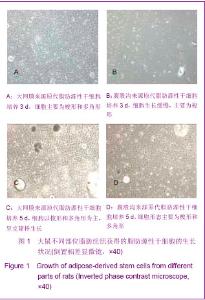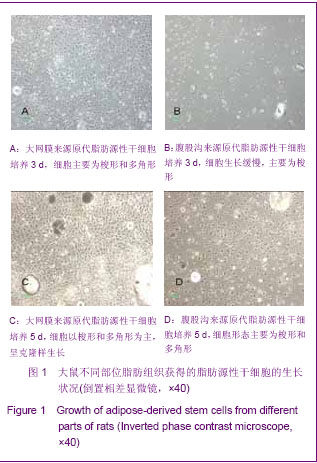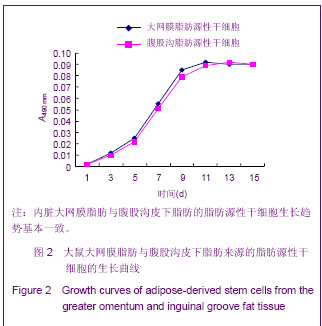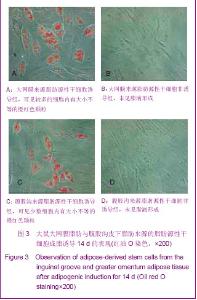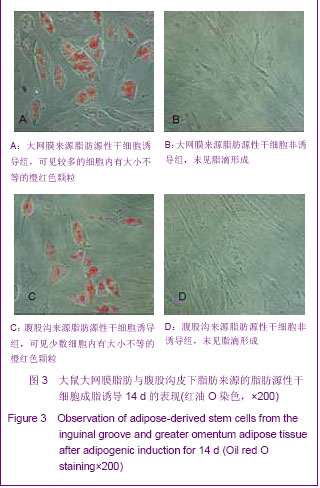| [1] Zuk PA, Zhu M, Mizun OH, et al. Multilineage cells from human adipose tissue: implications for cell-based therapies. Tissue Eng. 2001;7(2):211-228.[2] Tholpady SS, Katz AJ, Ogle RC. Mesenchymal stem cells from rat visceral fat exhibit multipotential differentiation in vitro. Anat Rec A Discov Mol Cell Evol Biol. 2003;272(1): 398-402.[3] Zuk PA, Zhu M, Ashjian P, et al. Human adipose tissue is a source of multipotent stem cells. Mol Biol Cell. 2002;13(12): 4279-4295.[4] Planat-Benard V, Silvestre JS, Cousin B, et al. Plasticity of human adipose lineage cells toward endothelial cells: physiological and therapeutic perspectives. Circulation. 2004;109(5):656-663.[5] Nakagami H, Morishita R, Maeda K, et al. Adipose tissue-derived stromal cells as a novel option for regenerative cell therapy. J Atheroscler Thromb. 2006;13(2):77-81.[6] Gimble JM, Guilak F, Bunnell BA. Clinical and preclinical translation of cell-based therapies using adipose tissue-derived cells. Stem Cell Res Ther. 2010;1(2):19.[7] Yoshimura K, Suga H, Eto H. Adipose-derived stem/progenitor cells: roles in adipose tissue remodeling and potential use for soft tissue augmentation. Regen Med. 2009; 4(2):265-273.[8] Yoshimura K, Sato K, Aoi N, et al. Cell-assisted lipotransfer for cosmetic breast augmentation: supportive use of adipose-derived stem/stromal cells. Aesthetic Plast Surg. 2008;32(1):48-57.[9] Matsumoto D, Sato K, Gonda K, et al. Cell-assisted lipotransfer: supportive use of human adipose-derived cells for soft tissue augmentation with lipoinjection. Tissue Eng. 2006;12(12):3375-3382.[10] Djian P, Roncari AK, Hollenberg CH. Influence of anatomic site and age on the replication and differentiation of rat adipocyte precursors in culture. J Clin Invest. 1983;72(4): 1200-1208.[11] Sowa Y, Imura T, Numajiri T, et al. Adipose-derived stem cells produce factors enhancing peripheral nerve regeneration: influence of age and anatomic site of origin. Stem Cells Dev. 2012;21(11):1852-1862. [12] Shu W, Shu YT, Dai CY, et al. Comparing the biological characteristics of adipose tissue-derived stem cells of different persons. J Cell Biochem. 2012;113(6):2020-2026. [13] Sowa Y, Imura T, Numajiri T, et al. Adipose-derived stem cells produce factors enhancing peripheral nerve regeneration: influence of age and anatomic site of origin. Stem Cells. 2012;21(11):1852-1862.[14] 袁启龙,曾小勇,李平,等.兔不同部位脂肪干细胞体外培养的生物学特性比较[J].中国组织工程研究与临床康复,2008,12(38): 7511-7514.[15] von Süßkind-Schwendi M, Ruemmele P, Schmid C, et al. Lung transplantation in the fischer 344-wistar kyoto strain combination is a relevant experimental model to study the development of bronchiolitis obliterans in the rat. Exp Lung Res. 2012;38(3):111-123.[16] Khan M, Meduru S, Pandian RP, et al. Effect of oxygenation on stem-cell therapy for myocardial infarction. Adv Exp Med Biol. 2011;701:175-181. [17] 中华人民共和国科学技术部.关于善待实验动物的指导性意见. 2006-09-30.[18] Jackson IT, Simman R, Tholen R, et al. A successful long-term method of fat grafting: recontouring of a large subcutaneous postradiation thigh defect with autologous fat transplantation. Aesthetic Plast Surg. 2001;25(3):165-169.[19] Yoon E, Dhar S, Chun DE, et al. In vivo osteogenic potential of human adipose-derived stem cells/poly 1actide-co-glycolic acid constructs for bone regeneration in a rat critical-sized calvailal defect model. Tissue Eng. 2007;13(3)619-627.[20] Fraser JK, Schreiber R, Strem B, et al. Plasticity of human adipose stem cells toward endothelial cells and cardiomyocytes. Nat Clin Pract Cardiovasc Med. 2006;3 Suppl 1:S33-37.[21] De Ugarte DA, Ashjian PH, Elbarbary A, et al. Future of fat as raw material for tissue engineering. Ann Plast Surg. 2003; 50(2):215-219.[22] Aust L, Devlin B, Foster SJ, et al. Yield of human adipose-derived adult stem cells from liposuction aspirates. Cytotherapy. 2004;6(1):7-14.[23] Wickham MQ, Erickson GR, Gimble JM, et al. Multipotent stromal cells derived from the infrapatellar fat pad of the knee. Clin Orthop Relat Res. 2003;4(12):196-212.[24] Sen A, Lea-Currie YR, Sujkowska D, et al. Adipogenic potential of human adipose derived stromal cells from multiple donors is heterogeneous. J Cell Biochem. 2001;81(2): 312-319.[25] Patrick CW Jr, Chauvin PB, Hobley J, et al. Preadipocyte seeded PLGA scaffolds for adipose tissue engineering. Tissue Eng.1999;5(2):139-151.[26] Lee JA, Parrett BM, Conejero JA, et al. Biological alchemy: engineering bone and fat from fat-derived stem cells. Ann Plast Surg. 2003;50(6):610-617.[27] 赵建辉,易成刚,郭树忠.脂肪来源干细胞的基础研究进展[J].中国美容医学,2011,20(3):512-515.[28] 杨楠.取脂部位不同对自体脂肪颗粒注射移植疗效影响的临床研究[J].中国美容医学,2005,15(7):775-777.[29] Tholpady SS, Katz AJ, Ogle RC. Mesenchymal stem cells from rat visceral fat exhibit multipotential differentiation in vitro. Anat Rec A Discov Mol Cell Evol Biol. 2003;272(1):398-402.[30] Katz AJ, Llull R, Hedrick MH, et al. Emerging approaches to the tissue engineering of fat. Clin Plast Surg. 1999;26(4): 587-603.[31] Hudson DA, Lambert EV, Bloch CE. Site selection for fat autotransplantation: some observations. Aesthetic Plast Surg. 1990;14(3):195-197.[32] Vallée M, Côté JF, Fradette J. Adipose-tissue engineering: taking advantage of the properties of human adipose-derived stem/stromal cells. Pathol Biol (Paris). 2009;57(4):309-317 |
